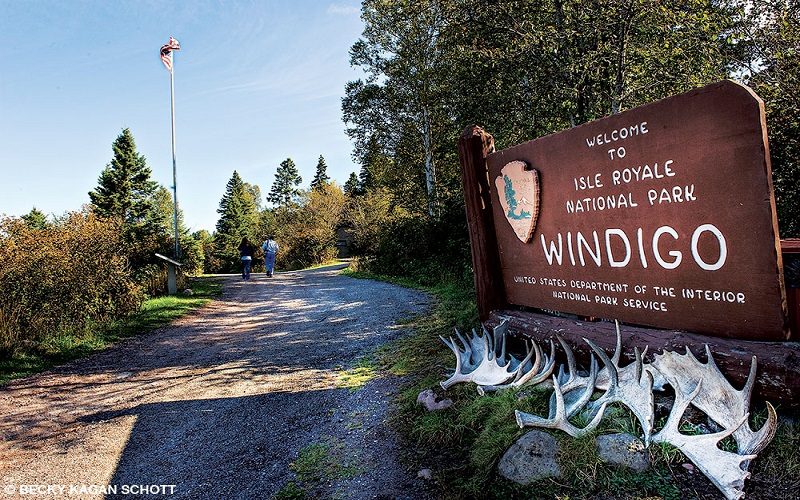Picture this: You wake up to a cool, foggy morning, and as you peer out across an isolated bay a moose is swimming in the sunrise. You are on an island in Lake Superior surrounded by stunning nature. As you sip your morning coffee and walk along the shoreline, you pass bushes of wild blueberries and enjoy the rocky shore before heading out on the water to visit incredible shipwrecks with powerful stories.
Some places we visit capture our hearts, and that is how I feel about Isle Royale, a remote island in the northwest corner of Lake Superior. The island belongs to the state of Michigan, but when you are there you find yourself in an isolated wilderness that is best experienced by spending a few days to a week at a time exploring it.

The 45-mile-long island was established as a national park in 1940. Isle Royale has a rich history of copper mining and fishing. Several lighthouses there have been converted to shipwreck museums. The island lies along a historic shipping route, and its notorious violent weather, remoteness, cold, fog and underwater geology have contributed to many shipwrecks over the years. The area’s wrecks range in age from a 19th-century paddle wheeler to modern freighters.
One of the biggest draws of Lake Superior diving is the lack of mussels. It is exciting to be able to see the ships’ fine details — such as paint on the hull, name plates on machinery, telegraphs and cargo — not covered up by mussels. The wrecks are preserved in the cold, fresh water, and because the sites are protected, many artifacts remain for divers to see.
Chester A. Congdon
The Congdon was a 532-foot-long steel bulk freighter that sank 99 years ago after hitting Canoe Rocks. The entire crew was saved, and salvage progressed until a gale came through two days later and broke the ship in half, sending it plummeting to the bottom. The bow broke from the stern and lies in just 50-100 feet of water, facing upward. The stern hit the bottom so hard it forced the rudder through the hull and sits at a steep incline between 50 and 200 feet.

The bow has a picturesque intact wheelhouse, and there are some penetration opportunities inside. If you swim the perimeter you will find pieces of twisted and mangled steel from the impact scattered around the rocks.
The stern line attaches to the wreck at 80 feet; from there you follow the massive cargo holds downward at a steep angle. At around 190 feet the massive rudder comes into view, and it is hard to believe it was pushed upward through the stern of the ship. It is quite a sight, showing how powerful the impact must have been when the ship hit the bottom. There is a double wheel, and just behind that is the wreck’s huge and wide-open engine room. Because the ship was salvaged, there is not much left inside, but some gauges are on the wall and an American flag is painted on the engine.
SS Emperor
The wreck of the SS Emperor is the island’s most popular dive site. This impressive, 525-foot-long steel freighter sank in 1947, it too running aground on Canoe Rocks. Sinking fast, it took the lives of 12 crew members with it. Today the Emperor sits mostly intact and upright on the bottom. Mooring lines are on both the bow and the stern because the ship is so long it is tough to swim the entire thing in one dive, plus the middle is mostly cargo holds. The bow is damaged but starts as shallow as 25 feet with a windlass and machinery to see. The stern sits between 115 feet and 175 feet, and there are no shortages of places to explore. It is probably worth doing multiple dives to see the galley with pots still on the stove and the bunk rooms that ominously have boots still sitting next to the beds — haunting reminders that this is not an artificial reef but a grave site.

On the stern railing sits an auxiliary anchor with a shoe next to it along with spare propeller blades. There are light bulbs still intact and screwed into sockets all over the wreck. Advanced divers should not miss descending into the engine room. The skylights have collapsed, exposing the top of the engine and making it easy to drop inside. A memorial plaque dedicated to the crew is posted below a gauge panel. Light shines in through the portholes to make the triple-expansion steam engine a striking sight. There is even a tool bench with a vice. This site will truly leave you wanting more.
SS America

In 1928 the passenger ship America had just picked up a group on Isle Royale, but five minutes later it hit a submerged reef. Everyone made it to lifeboats, and within an hour the America sank along a steep cliff. Lying at depths between 2 feet and 85 feet, the ship can be seen from the surface. This is another extremely popular site to visit because of the depth and proximity to shore. Upon entering the water, divers can see the rock wall and the bow, which is often illuminated by sunbeams. Peering down, you will see the ship disappear into the depths. As you swim along the hull you will pass by the windlass, and a staircase can be seen by looking inside rooms. Inside there are intact cabins and many artifacts lying on the bottom. As you work your way down you will find the intact propeller and much of the stern cabin that collapsed and fell off to the port side of the wreck.
SS Henry Chisholm
This wooden steam-powered freighter sank almost 120 years ago, carrying 92,000 bushels of barley. It hit a submerged reef near the Rock of Ages Lighthouse while heading for the harbor. The wreckage is intermixed with two other ships, the Cox and Cumberland, that hit the same reef. The Chisholm’s stern broke away from the rest of the ship and sits nearby. Its double-expansion steam engine sits perfectly upright in 120-150 feet, and the drive shaft and single screw are attached. The engine is exposed, and if you look closely you can see a lot of detail etched into the wood nearby.

SS Kamloops

What happened to the Kamloops is still a mystery. It disappeared in December 1927 with its entire crew. In May 1928 fishermen found the bodies of several crew members who had died of exposure. It was not until 1977 that the wreck was discovered and dived for the first time. The ship lies in 270 feet on its starboard side. Its cargo can be seen in the holds — there is wire fencing as well as crates of shoes and toothpaste, but the most interesting cargo are the wooden boxes of Life Savers candy. On the stern you can see the beautiful ship’s wheel along with the binnacle, telegraph and propeller. Wreckage, cargo and a single life boat are strewn over the bottom. One of the grimmest parts of the ship is its engine room, where the remains of a crew member rest, eternally on duty.
Diving these shipwrecks and then returning to the beautiful islands, cliffs and shorelines brings the stories alive. When thick fog and storms roll in and you witness the fury of Lake Superior, you cannot help but gain a lot of respect for the sailors who navigated these waters without the technology we have today. Superior’s wrecks are truly superior, and seeing them in their preserved state is like going back in time or floating through an underwater museum of the Great Lakes.
How to Dive It
Getting there: Currently one dive operator, Isle Royale Charters, runs five-day liveaboard trips to the island. The boat leaves from Grand Portage, Minn., and typically takes a few hours to cross to the island.

Conditions: The dive season is June through September, when the water is warm enough to dive. Water temps can vary from mid-30s°F in June to 50s°F in August. Air temperatures can range from 50°F to 75°F, so bring a variety of clothing with you. A drysuit and dry gloves or a 7 mm wetsuit with gloves and a thick hood is recommended year-round. Visibility is typically 40-60 feet, and there is little to no current.
Topside: The national park is well maintained and has miles of hiking trails lined with wild thimbleberries and flowers. Wildlife such as moose, fox and bald eagles can be seen. The trails lead to abandoned fishing villages, lighthouses and scenic views along Lake Superior. Kayaking and fishing are allowed in the park.
© Alert Diver — Q1 2018